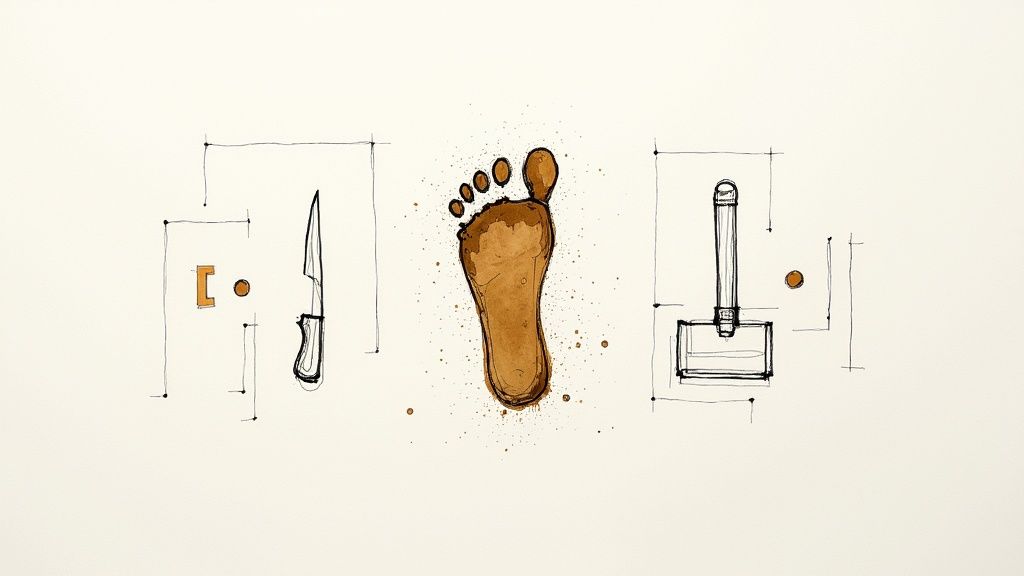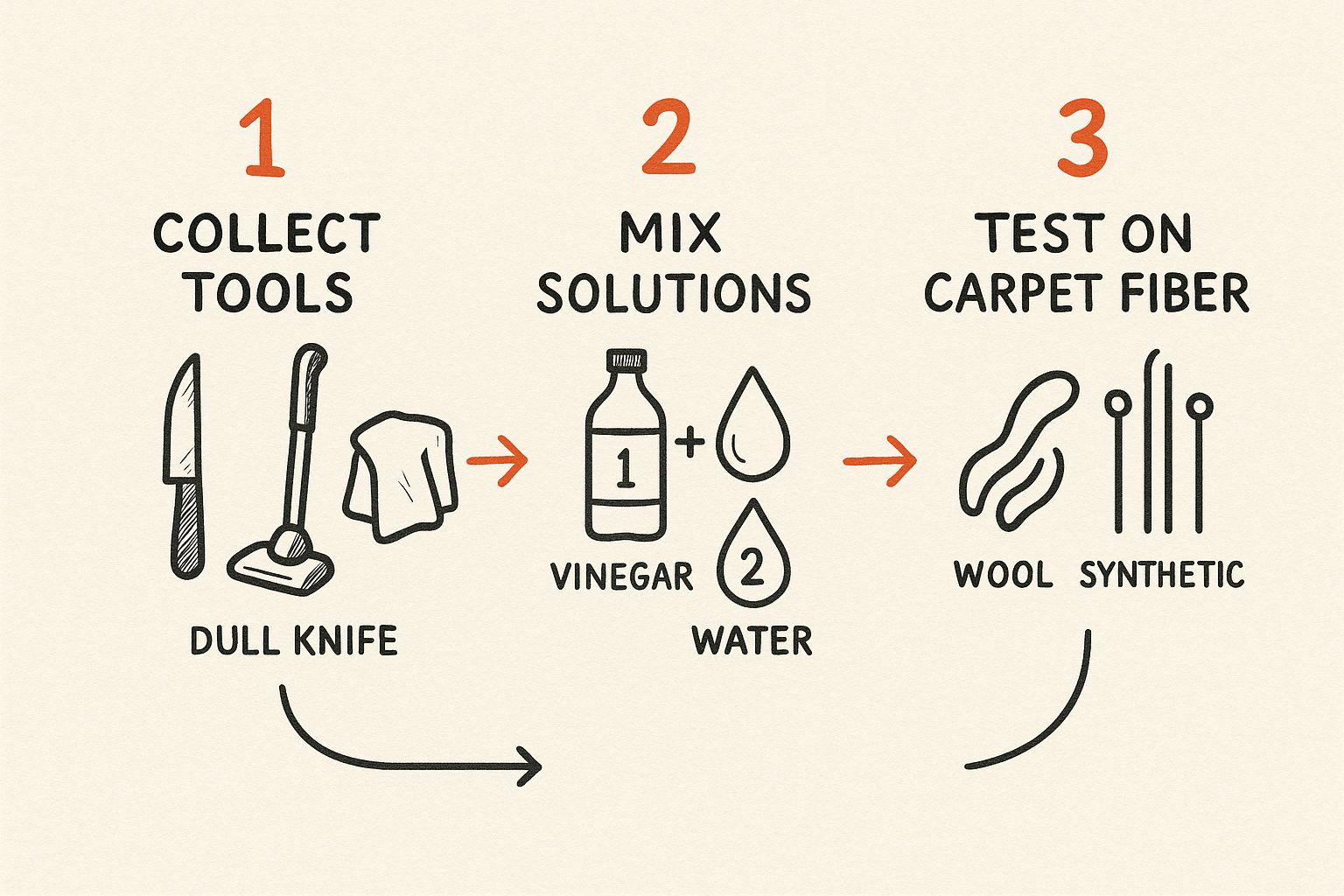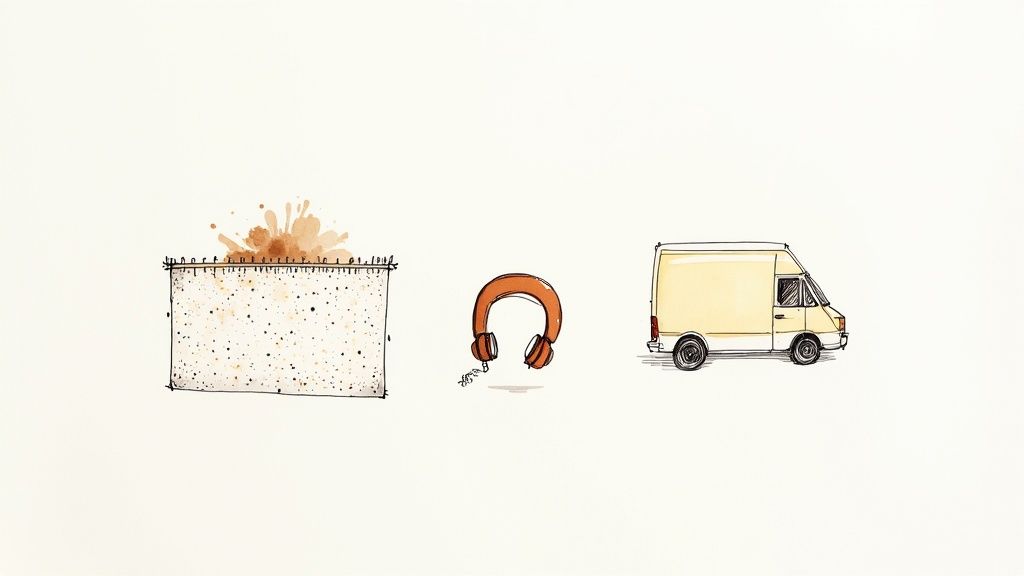When a muddy shoe or a happy pet’s pawprint lands on your clean carpet, that sinking feeling in your stomach is all too familiar. Your first instinct is probably to grab a wet rag and start scrubbing like mad.
Stop right there. That is the single worst thing you can do.
The trick to actually getting mud out of your carpet is counterintuitive but incredibly effective: let it dry completely first. Seriously. Attacking wet mud just grinds the abrasive soil particles deeper into the carpet fibers, turning a small oops into a giant, smeared-in mess.
Your First Move When Mud Meets Carpet

Patience is your best friend here. Let the mud dry out, which might take a few hours depending on how big the mess is. This simple act of waiting transforms the sticky smear into a brittle, solid chunk that basically just sits on top of the carpet fibers instead of being ground into them.
Containing the Initial Mess
Once the mud is totally hard and dry, it's time to get to work. Your approach will change slightly based on what kind of carpet you have.
- For low-pile carpets (think Berber or other looped styles), grab a dull butter knife or a spatula. You can gently pry and scrape off the bigger, caked-on pieces of dirt without much fuss.
- For high-pile or plush carpets, you need to be a bit more careful. Use your fingers or the edge of a spoon to break up the dried mud. This helps you avoid snagging or pulling out those long, lovely fibers.
The whole point is to lift away as much of the solid dirt as you can before you even think about adding any liquid. After you've scraped and broken up the clumps, bring out the vacuum. Use a hose attachment to get right on top of the spot and suck up all that loose debris. You’ll be shocked at how much of the "stain" disappears with just these two steps.
If you're in a panic, just remember these quick essentials.
Mud Stain First Aid At a Glance
| Tool or Action | Primary Purpose | Ideal for Carpet Type |
|---|---|---|
| Patience | Allows mud to dry completely, preventing smearing. | All types |
| Dull Knife/Spatula | Scrapes off large, caked-on pieces of dried mud. | Low-pile (Berber, looped) |
| Fingers or Spoon | Gently breaks up dried mud without snagging fibers. | High-pile (plush, shag) |
| Vacuum (Hose) | Sucks up all loose, dry debris after scraping. | All types |
This quick-response kit prepares you for the next phase of cleaning, ensuring you've done the heavy lifting first.
Key Takeaway: Fighting the urge to clean wet mud is the most important step. In my experience, over 80% of the soil can be removed by just letting it dry and vacuuming. This makes the final spot treatment so much easier and more effective.
Getting this initial containment right is what prevents a small accident from becoming a permanent, ugly fixture on your floor.
Assembling Your Mud Removal Toolkit
Getting a mud stain out of your carpet doesn't mean you need a shelf full of expensive, specialized chemicals. In fact, you probably have everything you need to build a powerhouse mud-removal kit right in your kitchen pantry and cleaning closet. Gathering these items ahead of time means you can jump into action the moment you spot the mess.
The physical tools for this job are pretty simple but incredibly effective. You'll want to grab a dull knife or even a spoon to gently scrape away any caked-on bits, a strong vacuum with a hose attachment to suck up all the loose dirt, and a few clean, white cloths or paper towels for blotting. Using white cloths is a non-negotiable—colored ones can bleed dye right into your carpet fibers when they get wet.
Simple and Safe Cleaning Solutions
When it comes to the actual cleaning solution, a couple of DIY mixes work wonders and are safe for most carpets. It's always a good idea to understand the best way to get spots out of carpet before you start, and these simple recipes are the perfect place to begin.
- Vinegar and Water: Mix a solution of one part white vinegar to one part cool water. This mild acid is fantastic at breaking down dirt, especially on synthetic carpets like nylon or polyester.
- Mild Dish Soap: For a gentler touch, particularly if you have natural fibers like wool, mix a tiny amount—about a quarter teaspoon of clear, mild dish soap—into a cup of lukewarm water. Steer clear of any soaps with colors or heavy scents.
This infographic gives you a quick visual breakdown of getting your tools together and choosing the right solution.

As you can see, it really boils down to three phases: collecting the physical tools, mixing your chosen cleaning liquid, and making sure that mix is safe for your specific type of carpet.
Expert Tip: Before you go all-in on the stain, always test your cleaning solution on a small, hidden patch of carpet. Think inside a closet or under the sofa. This quick spot check makes sure the solution won't bleach or damage the fibers, giving you the confidence to tackle the real mess.
Tackling Dried Mud Stains: A Practical Guide
So, that wet mud patch is now a dry, crusty mess. Good. This is exactly what we wanted. When the mud is completely dry and brittle, you’re in the perfect position to remove it without accidentally making a bigger stain. The first part of this process is all about physical force—no liquids just yet.
Go grab something dull like a butter knife, the edge of a spoon, or even a plastic scraper. You’ll want to gently chip away at the solid, caked-on mud. Always work from the outside of the stain inward. This keeps you from spreading the mess. The idea is just to break up the large, solid chunks so your vacuum can handle them.
Once you’ve loosened all the heavy stuff, it’s time to vacuum. For the best results, use your vacuum’s hose attachment to get the most direct suction power. Go over the spot slowly and hit it from a few different angles. You’ll be shocked at how much comes up—often up to 80-90% of the visible mess is gone after this step alone.
Treating What's Left Behind
With the solid dirt gone, you can now deal with the faint stain that’s still hanging around. But before you spray anything on it, you absolutely have to do a spot test.
Find a hidden piece of carpet—think inside a closet or under the sofa—and apply a small amount of your cleaning solution. Wait a few minutes, then blot it with a clean white cloth. If you don't see any color coming off the carpet or any weird changes to the fibers, you’re good to go. This simple check can save you from turning a small mud stain into a permanent, discolored eyesore.
It's no surprise that people are looking for better ways to keep their homes clean. The global carpet cleaner market was valued at USD 1.13 billion in 2023 and is only expected to grow. It just shows how much we all want clean, comfortable living spaces. You can explore the full market research if you're curious about the trends.
The Blot and Rinse Method
Now, take a clean, white cloth and get it slightly damp with the cleaning solution you just tested. Gently blot the stain. Whatever you do, don't rub or scrub it. That’s a surefire way to fray your carpet fibers and push the dirt even deeper into the pile.
Breaking Down the Blotting Technique:
- Press Down: Apply firm but gentle pressure with your damp cloth directly onto the stain.
- Lift Up: Pull the cloth straight up. This lifts the soil out of the carpet fibers instead of smearing it around.
- Repeat: Switch to a fresh, clean section of your cloth for each blot to avoid putting dirt back onto the carpet.
Keep blotting until you can’t see the stain anymore. Once it's gone, lightly mist the area with some clean, cool water and blot it again with a completely dry towel. This rinses out any leftover cleaning solution so you don't end up with a sticky spot.
Finally, just let the area air dry. If you want to speed things up, you can aim a fan at the spot. This last step is crucial for preventing those annoying water rings and leaving your carpet looking perfect. For really stubborn issues, sometimes a different cleaning method is in order; looking into the benefits of dry carpet cleaning can be a great alternative that uses minimal moisture.
Dealing With Big, Wet Mud Spills

Okay, so I know the golden rule is to let mud dry. But life isn't always that neat. Sometimes a dog barrels in from the rain and leaves a huge, sloppy mess, or a kid’s boot drops a pile of mud that’s just too big to ignore.
In these situations, you have to act fast before all that moisture seeps deep down into your carpet padding. Your goal isn't to clean it yet—it's to contain the damage.
First, grab a spoon or a butter knife and carefully scoop up the solid stuff. Always work from the outside edges of the spill toward the middle. This is crucial—if you scoop outward, you’ll just make the muddy disaster zone even bigger.
The Art of Blotting (Not Scrubbing!)
After you've removed the big chunks, you'll be left with a damp, muddy patch. Now your job is simple: get rid of as much moisture as you can.
Take a clean, dry, absorbent white towel and gently blot the area.
Seriously, whatever you do, do not scrub a wet mud stain. Scrubbing just grinds those tiny dirt particles deeper into the carpet fibers. It can cause permanent damage and sets you up for a much tougher stain to remove later. You're trying to lift the moisture, not attack the stain.
Blotting is a patient process. Press the towel down firmly, hold for a few seconds, and lift straight up. As one part of the towel gets saturated, fold it over to a fresh, dry section and repeat. Keep going until the spot feels only slightly damp.
Once you’ve managed the immediate crisis, you can go back to the original rule: let it air dry completely. The carpet cleaning market has exploded, reaching around USD 1.66 billion recently, because so many people are looking for real answers to messes just like this. You can read more about the rise of carpet care products to see why using the right technique is so important.
After the spot is bone dry, you can come back with a vacuum and then treat any discoloration that’s left behind.
When It's Time to Call in a Professional

Sometimes, even with the best intentions and a whole lot of elbow grease, a mud stain simply refuses to give up. This happens a lot with certain types of mud, especially the stubborn red clay we see around here, which can act more like a dye than just dirt. Delicate materials like wool are another story—they can be easily damaged if you get too aggressive.
If you’ve tried all the tricks and you’re still staring at a stubborn brown shadow on your floor, it’s probably time to call for backup.
Professionals bring out the big guns for a reason. Their gear, especially the hot water extraction machines (often called steam cleaners), uses a combination of high-pressure hot water and incredibly powerful suction that the rental or home-use machines just can't compete with. This process doesn't just clean the surface; it flushes out all that deeply embedded soil from the carpet fibers and even the pad underneath.
Signs You're Fighting a Losing Battle
You should probably put down the spray bottle and pick up the phone if you start to see any of these tell-tale signs:
- The Ghost Stain: You clean the spot, it looks great while it's damp, but once it dries, a faint shadow mysteriously reappears. This is a classic sign the dirt is wicking up from deep in the carpet padding.
- Color Bleeding: You notice the dye in your carpet is starting to run or bleed. This is a huge risk, especially with colorful oriental or wool rugs, and can cause permanent damage.
- Making It Worse: Your cleaning attempts seem to be spreading the stain, making it bigger, darker, or more noticeable than when you started.
There's a reason the professional carpet cleaning industry is booming. The global market is projected to hit USD 15.8 billion by 2033, because people know that sometimes you need an expert touch for effective maintenance. You can read more about the industry's growth at datahorizzonresearch.com.
When you're up against a truly tough stain, investing in a professional deep carpet cleaning service doesn't just save your carpet—it saves you a ton of time and frustration, too.
Your Top Mud Stain Questions, Answered
Even when you've done everything right, a few questions can still bubble up. Getting these sorted out will help you handle those really tough situations and, hopefully, keep future messes to a minimum. Let's tackle some of the most common worries I hear from homeowners.
Can I Use a Steam Cleaner on a Mud Stain?
I get this one a lot. It’s tempting to break out the home steam cleaner, but you absolutely want to avoid using it—or any hot water—on a fresh mud stain. Heat will literally cook the proteins in the soil right into your carpet fibers. It creates a chemical bond that can set the stain for good, making it a nightmare to remove later.
When you're mixing up DIY solutions or rinsing the area, always stick with cool or lukewarm water.
Now, it’s important to know that a professional's hot water extraction system is a completely different animal. Those powerful machines use specific cleaning agents and massive suction to flush out stains without setting them. It's a level of power and precision a home unit just can't match.
What’s the Deal with Red Clay Mud?
Ah, red clay. It’s the arch-nemesis of clean carpets, especially here in Georgia. The problem is its high iron oxide content, which basically acts like a potent dye. Even after you’ve removed all the actual dirt, it can leave behind a stubborn reddish-orange reminder.
If your standard cleaning attack leaves a stain behind, you can try something stronger, but you have to be extremely careful.
- For synthetic carpets only: A mix of one part ammonia to two parts cool water can sometimes break down the iron stain.
- Don't skip this: You must test this solution on a hidden spot first—like inside a closet—to make sure it doesn’t bleach or otherwise ruin your carpet’s color.
Honestly, if you're up against a stubborn red clay stain, this is one of those times it’s probably best to call in a professional. They have specialized treatments specifically designed to neutralize iron-based stains without damaging your carpet.
How Can I Stop This from Happening Again?
The easiest stain to deal with is the one you never have to clean. A little prevention goes a long, long way. Put high-quality doormats at every single door. I recommend one outside for scraping off the heavy stuff and another one just inside to catch whatever is left.
A simple "no-shoes" rule in the house is a game-changer, particularly when it's wet and mucky outside. And for all the pet owners out there, keep an old towel and a paw washer right by the door. A quick wipe-down before your furry friend gets a chance to zoom through the house can save you so much trouble.
When prevention isn't enough and a tough stain just won't budge, don't be afraid to call for backup. The experts at Citrus Carpet Cleaning Buford use a low-moisture, citrus-based system that gets the job done without leaving any sticky, dirt-attracting residue. Get your free "EXACT-imate" and see the difference by visiting https://citruscarpetcleaningatlanta.com today.

